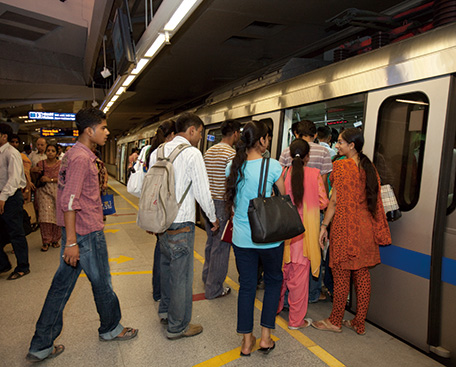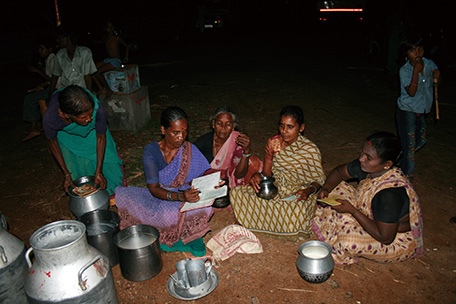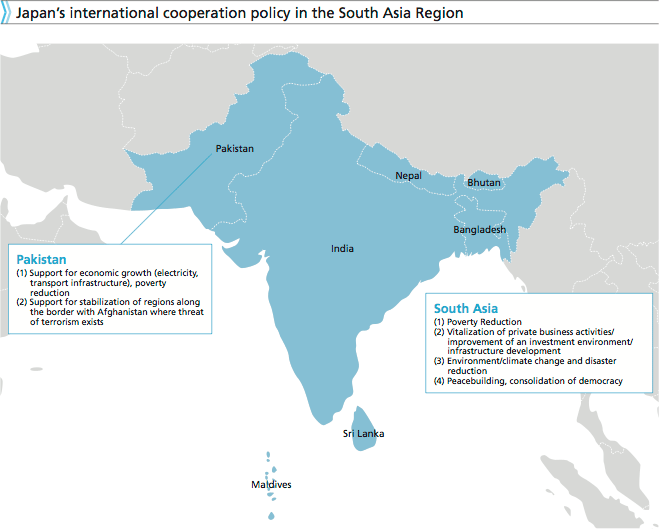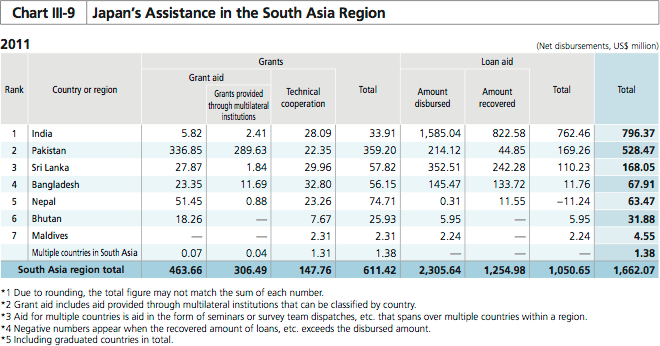Japan's Official Development Assistance White Paper 2012
2. South Asia
The South Asian region that has a high rate of economic growth and enormous economic potential, particularly India, the world's largest democracy, has been increasing its presence in the international community. South Asia is strategically important to Japan because of its location on a sea lane that connects East Asia with the Middle East, and is also crucial in responding to the global environmental issues. In addition, the region is of great interest to Japan and the rest of the international community due to the role it plays in international efforts against terrorism and extremism.
At the same time, the South Asian region still faces many issues that must be addressed, including a severe lack of basic infrastructure such as roads, railroads, and ports, growing populations, low school enrollment ratios in primary education, inadequate water, sanitation, healthcare and medical facilities, insufficient maternal and child healthcare, a lack of countermeasures against infectious diseases, and the absence of the rule of law. The poverty reduction is a particularly challenging problem. Approximately 500 million people of 1.6 billion of the region's population are said to be living in poverty, making it one of the world's poorest regions. South Asia is the second most important region behind Africa in aiming to achieve the Millennium Development Goals (MDGs)(Note 19).
Japan provides assistance focusing on improving the socio-economic infrastructure in order to harness the economic potential of South Asia as well as to alleviate the growing gap between the rich and the poor.
<Japan's Efforts>
In its relationship with India, a key player in South Asia, Japan promotes cooperation in a wide range of fields based on the "Strategic and Global Partnership." These include economic cooperation on projects such as the Dedicated Freight Corridor (DFC) which will be the core of the Delhi Mumbai Industrial Corridor (DMIC), politics and security, economy, and scholarly exchange. India is the largest recipient of Japan’s ODA loans, and Japan focuses on providing assistance for the development of economic infrastructure, mainly in the field of power and transport as well as social sector development such as improvements to the rural environments aimed at poverty reduction.
In May 2009, the military conflict between government troops and the Liberation Tiger of Tamil Eelam (LTTE) that had lasted almost 26 years in Sri Lanka came to an end. Japan provides aid to promote peacebuilding and socio-economic development in Sri Lanka, while giving consideration to regional and ethnic balance, and the progression of national reconciliation.

The subway has become a major mode of transportation in Delhi, India. (Photo: Shinichi Kusano/JICA)
Pakistan plays an important role in international cooperation to combat terrorism. Japan supports stable growth of Pakistan by strengthening its socio-economic infrastructure. Some of Japan's efforts include an assistance of up to $1 billion over two years pledged at the Pakistan Donors Conference hosted by the World Bank and Japan in April 2009 and the dispatch of the Japan Disaster Relief (JDR) Team and the contribution of a total of $568 million in response to flood damage in 2010. In addition, when President Asif Ali Zardari visited Japan in February 2011, the Joint Statement on Japan-Pakistan Comprehensive Partnership(Note 20) was signed, and Japan agreed to continue providing support to enhance mutually beneficial economic and trade activities, to assist Pakistan in efforts to develop the power sector, water resources, and infrastructure, and to ensure human security. (See this for more details regarding Pakistan)
Note 19: According to the 2010 MDGs Report, the percentage of people living on approximately one dollar per day was 39% (as of 2005), a figure only exceeded by Sub-Saharan Africa.
Note 20: Joint Statement on Japan-Pakistan Comprehensive Partnership
●India
Tamil Nadu Biodiversity Conservation and Greening Project
ODA Loan (February 2011 - Present)
The richly biodiverse state of Tamil Nadu in the southern part of India contains 28 protected areas and are home to 553 endemic flora and fauna. Unfortunately, 230 of those species are on the verge of extinction, and since so many people depend on forest resources for livestock feed, fuel and income, there are times when negative effects on biodiversity are inevitable.
Through ODA loans, Japan is eliminating invasive species in order to preserve ecosystem and is enhancing abilities to manage protected areas where many precious species live. Japan also supports a wide variety of activities such as ecotourism, programs to provide alternative sources of income for local residents, through planting trees, aquaculture, boosting livestock production on privately held land and teaching skills like how to make incense and furniture.
This support provides local citizens, mainly the poor people, with ways to improve their livelihoods and is expected to contribute to environmental conservation and harmonious, sustainable socioeconomic development in project areas. In addition, the planting of trees is expected to have the effect of reducing greenhouse gas emissions by approximately 400,000 tons every year.
(As of December 2012)

Women gathering milk. (Photo: JICA)


